

|
Have a great invention to help with gardening? Are you the self-reliant type that prefers Building It Yourself vs. buying it? Share and discuss your ideas and projects with other members.
|
 |
|
|
Thread Tools | Display Modes |
|
|
|
|
#1 |
|
Tomatovillian™
Join Date: May 2007
Location: SoCal - Zone 10
Posts: 106
|
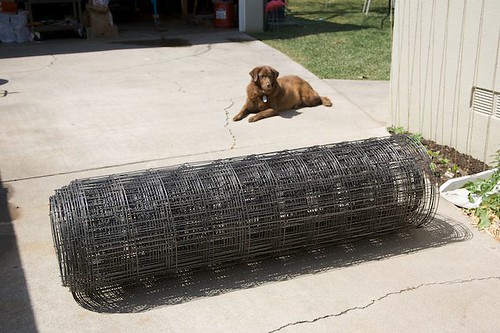 Home Depot sells 5x150' rolls of 6" concrete mesh for $120. Using 13 squares (6.5') per cage, one roll of mesh will make 23 cages. The full roll is heavy – 150lbs – so use a dolly or a friend to help you move it. 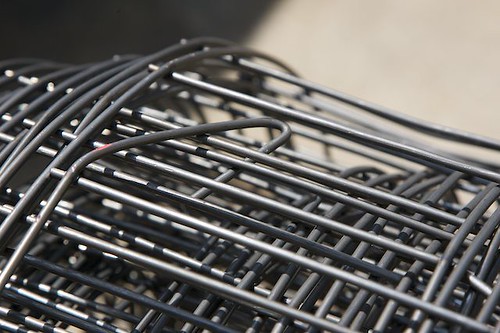 The ends are bent inward to keep the roll closed.  A-clamps or a helper will keep the roll from springing open when the ends are straightened out. 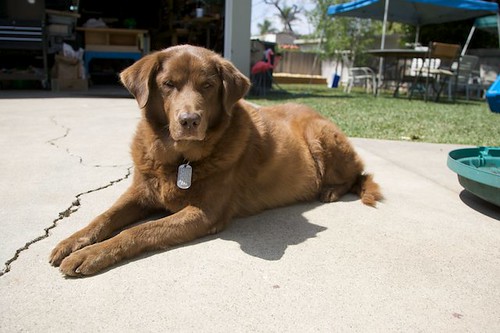 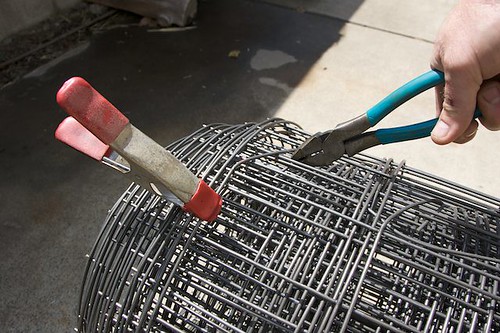 Get some good pliers to unbend and open the roll. The bigger and better the pliers, the less pain and soreness will be required.  Wood, bricks or container plants can be used to manage the roll and keep it from getting away from you. (It wants to unwind more than you may want it to...) 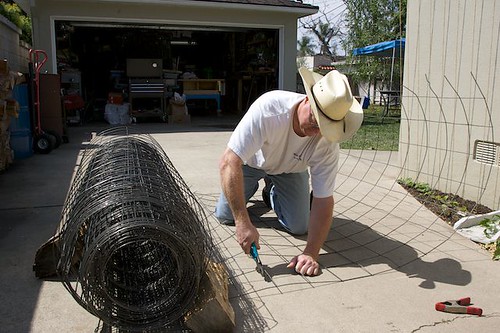 Count out the number of 6" squares for the size cage you want – I used 13 squares – and cut each horizontal wire tightly against the 5' vertical wire. That'll make all the ends the same length and give you a clean vertical wire at the beginning of the next 6.5' length. 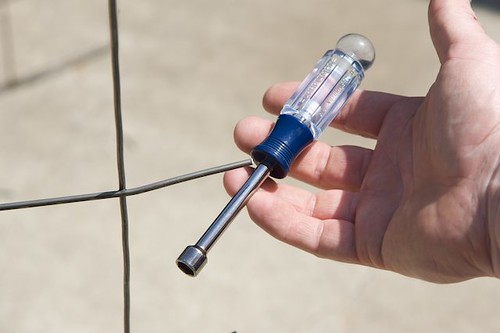 You can use the pliers to bend the ends – but I had a nut driver with a hole drilled about an inch or so up into the shaft. The fixed depth of the hollow gave me consistent length bends without having to measure.  Nut driver handle gave good leverage and straight, tidy bends. 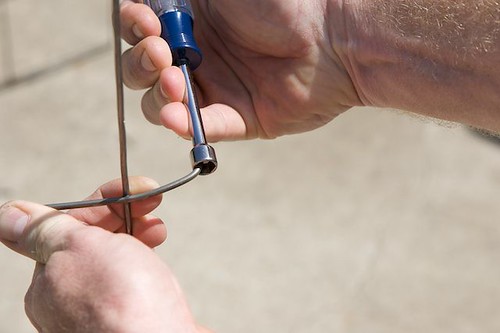 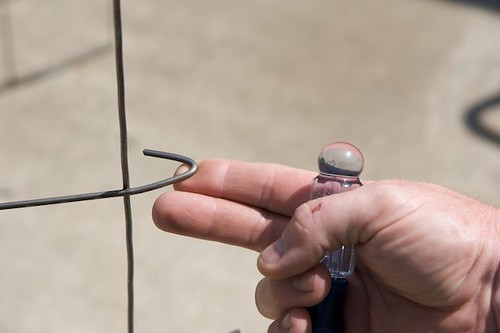 Bent ends form hooks that grab the vertical wire at the other end once rolled. 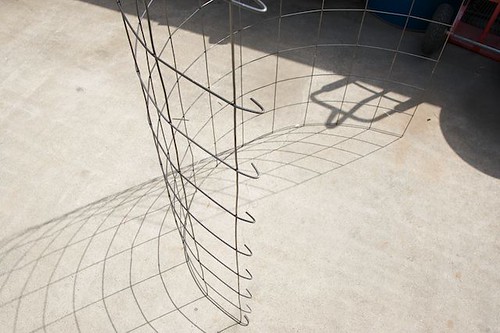  Overlapping the ends by one 6" square keeps the cage round and gives you something to hold onto when hooking all the ends in place. 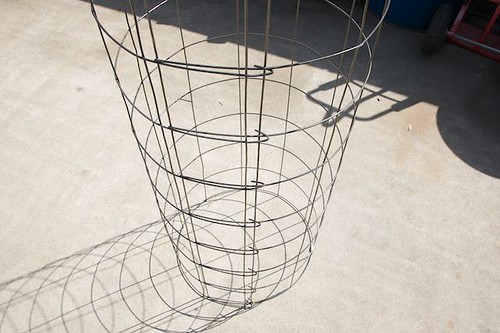  The cage should hold itself together without additional fasteners or welding. I used wire-ties to prevent any surprise movement or dismemberment that might occur once the cage is weighted down with tomatoes. |
|
|

|
|
|
#2 |
|
Tomatovillian™
Join Date: May 2007
Location: Santa Clara CA
Posts: 1,125
|
I bought a roll of the 5' last year. At 13 squares a cage it seemed like they made a 100 cages! I say better to buy in bulk. Good choice.
Damon |
|
|

|
|
|
#3 |
|
Tomatovillian™
Join Date: Mar 2009
Location: Tucson
Posts: 659
|
How big in circumference is that? I have 4ft high field fencing that was left over from an old fence maybe 30 ft long, and I was going to roll it all the way out cut 6 ft lengths and then make cages that way, but I don't know if it will be too small in circumference.
Thanks |
|
|

|
|
|
#4 |
|
Tomatovillian™
Join Date: Apr 2012
Location: Byron, GA
Posts: 24
|
Divide the length by 3.142 for the diameter. That 6' length would give you about a 2 ft. diameter. I have found that too large a cage allows the plant to fall over inside.
|
|
|

|
|
|
#5 |
|
Tomatovillian™
Join Date: Jul 2006
Location: Z8b, Texas
Posts: 657
|
__________________
It's not how many seeds you sow. Nor how many plants you transplant. It's about how many of them can survive your treatment of them  . .
|
|
|

|
|
|
#6 |
|
Tomatovillian™
Join Date: May 2007
Location: SoCal - Zone 10
Posts: 106
|
|
|
|

|
|
|
#7 |
|
Tomatovillian™
Join Date: Jan 2007
Location: PNW
Posts: 4,743
|
Circumference (length around the circle) = 3.1416 * diameter
(length across the circle) If his circumference is 6' (13 squares at 1/2 foot per square, minus 1/2 foot for the overlap, gives 6'), then his cages are 6'/3.1416 = a little less than 2' across. If he cut them the same and then rolled them up the other way (so that they would be taller), they would only be 4-1/2' in circumference, and they would only be about 17" across the circle (which probably seems a little tight and could lead to broken branches with fruit hanging outside the cage).
__________________
-- alias |
|
|

|
|
|
#8 |
|
Tomatovillian™
Join Date: Feb 2006
Location: Den of Drunken Fools
Posts: 38,539
|
What do you use to keep the cages from falling over?
Every spring here we get high winds, yesterday it was blowing around 45mph. Worth |
|
|

|
|
|
#9 |
|
Tomatovillian™
Join Date: Feb 2012
Location: s.central kansas
Posts: 35
|
i use a 1x2 about 5-6 ft long-put it in ground on south side and north side about8-10 in deep then tie top and bottom with some fine wire. they can take some really strong winds until they get really big(the plants) then i might put in another stake.with the dominent south winds 2 stakes are usually enough.
|
|
|

|
|
|
#10 |
|
Tomatovillian™
Join Date: Feb 2013
Location: Brantford, ON, Canada
Posts: 1,341
|
When I used cages, they were anchored by a one half inch diameter, six feet long rebar anchored to the cage using a plastic tie. Strong like bull. Now i use overhead strings.
|
|
|

|
|
|
#11 |
|
Tomatovillian™
Join Date: Feb 2006
Location: NJ z5
Posts: 281
|
Cattle panels should fit in a pickup bed. They are stiff, but still flexible. A full size bed is easier, but a short bed will do. If you load multiple panels, make sure that they all have the long, horizontal wires facing up- this makes it easier for them to slide against each other.
|
|
|

|
|
|
#12 |
|
Tomatovillian™
Join Date: Jan 2015
Location: Michigan
Posts: 10
|
You need to use 3 to 5 ft T-Posts or equivalent, and wire the cages to them.
|
|
|

|
|
|
#13 |
|
Tomatovillian™
Join Date: May 2007
Location: SoCal - Zone 10
Posts: 106
|
Worth –
I use screws and anchors for the cages next to the house in the driveway bed. Secure them near the top and they stay very well put. Going out today to get some 1/2" rebar to cut into 3' lengths for the free standing cages. I've got a few 3' fence-posts from another project that work very well. But they cost more than I feel is necessary. 
|
|
|

|
|
|
#14 |
|
Tomatovillian™
Join Date: Mar 2008
Location: SW Ohio
Posts: 1,818
|
Looks great! I am shocked you can buy the CRW that has no rust. Here, the rolls are nasty and you get covered in rust just loading them into your vehicle.
__________________
Barbee |
|
|

|
|
|
#15 | |
|
Tomatovillian™
Join Date: Feb 2006
Location: MO z6a near St. Louis
Posts: 1,349
|
Quote:
I used the galvanized wire from a large roll as in Thawley's photos. A large T-bar pounded into the ground and wired on supports the cage. DSC_7046 Tomato plot 04-July-2007.jpg
__________________
--Ruth Some say the glass half-full. Others say the glass is half-empty. To an engineer, it’s twice as big as it needs to be. |
|
|
|

|
 |
|
|
